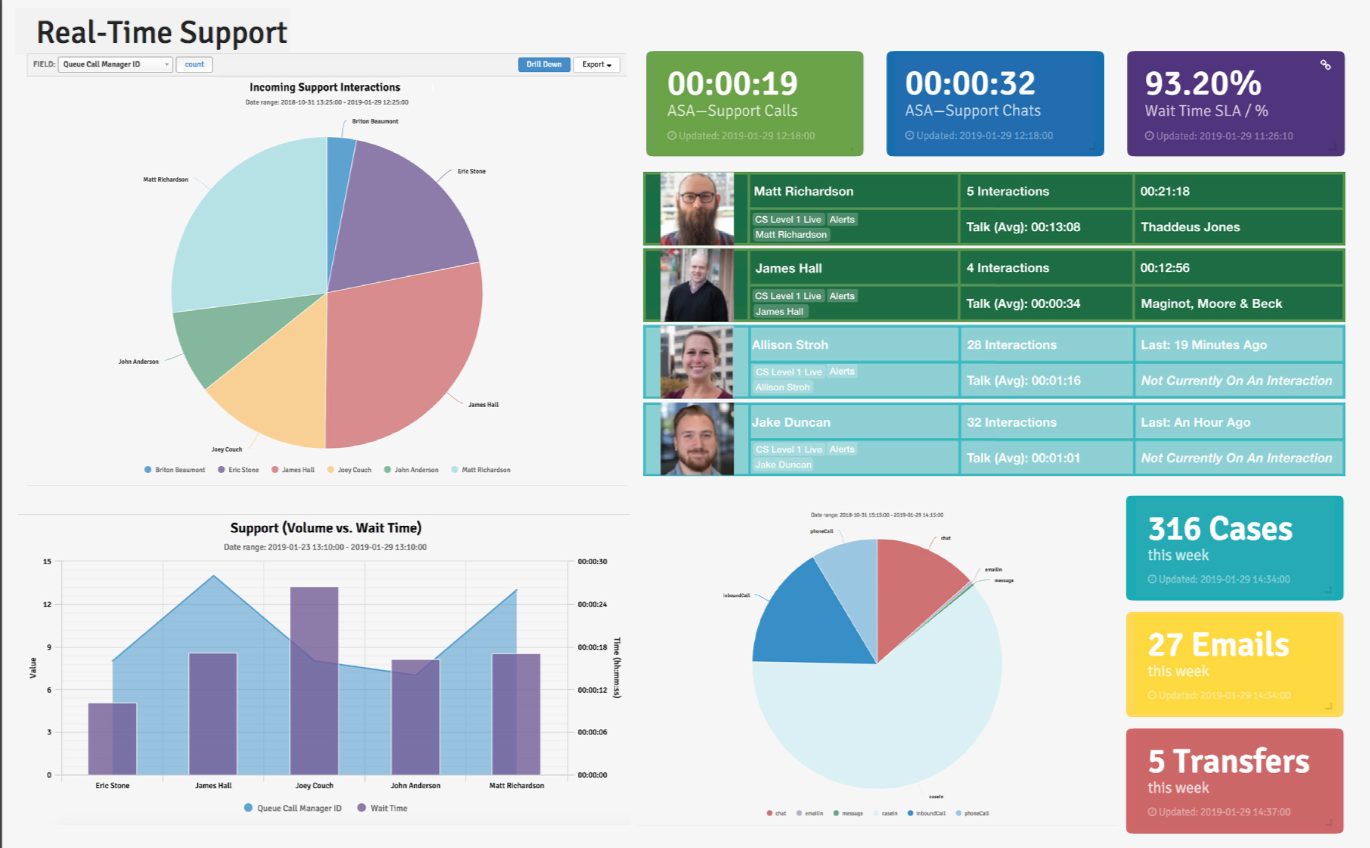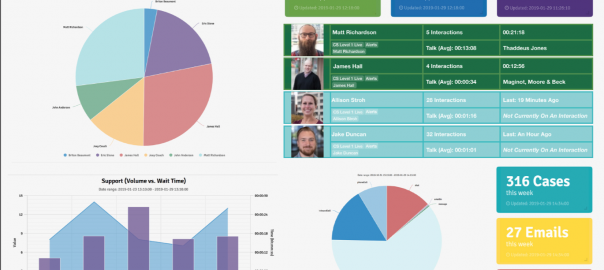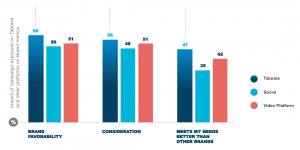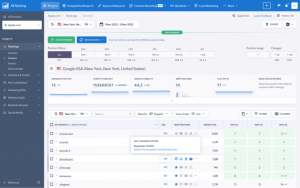Throwing a cloak of invisibility over your metrics drains agent performance.
When your agents don’t know how they’re measured or what metrics to hit, burnout looms on the horizon and agents can’t reach their full potential.
It’s not for a lack of effort, though. It’s because they don’t have the clarity and understanding they need to excel in their roles. And, because they can’t track their daily progress along the way.
Turns out, clear expectations are the most fundamental and basic employee need, according to Gallup. Not only that but, research from Jeff Toister found that agents who don’t have daily visibility into their metrics sit at an increased risk for burnout.
That’s why sharing custom reports and dashboards with your team is mission-critical to the service you deliver (and to the well-being of your call center agents).
But even with custom reporting tools and dashboards at your fingertips, it’s still hard to know what to share with your agents. One of the top five challenges plaguing call center agent performance this year is how much of your agents’ time gets sucked up by low-value work. And, the lack of context agents have about their customers.
As you create and share dashboards and data with your team, you worry if you’re making them spend too much time out of their queues. Do the dashboards you share drive up performance? Or, do they fall into the “low-value” work category? What’s too much information? And what’s too little? Which metrics accelerate performance, and which send agents into a frenzy?
We’re answering these pressing questions and sharing the four mistakes you’re making with agent dashboards and reports. Plus, how to reverse them for revved-up call center agent performance.
1. You aren’t sharing the “why” behind your metrics.
It’s hard to improve your performance if you don’t know what you’re working toward.
When I had to save money for a house – it was tough. It meant cutting spending and stashing away the cash I’d typically put toward vacations or my rainy-day activities. But I knew the final outcome – owning my first home and ditching my small, smoke-stenched apartment – was worth it. I had a “why” to motivate me and drive my actions.
When you share reports and dashboards with your team to drive up agent performance in your call center, it’s not enough to just bring visibility to key metrics and crack the whip until agents meet performance standards. You have to communicate the “why” behind each metric you share – and why viewing and tracking those metrics in daily, weekly, or monthly dashboards matters.
In a recent Harvard Business Review article, Nancy Durate of Durate, Inc., explained how important it is to clarify goals and expectations with “why” statements. And, how following every “why” statement with a “because” statement links expectations back to your ultimate goals.
Let’s say you create a weekly email send to share a CSAT dashboard with your team. The dashboard highlights CSAT, Average Handle Time and First Contact Resolution. Don’t just share out the dashboard and leave it open to interpretation. Explain to your agents why you’re tracking these metrics and why they’re so important to reaching your overarching goals. Use the why/because format to clarify the impact to your team.
A why/because statement explaining why metrics matter:
We’re tracking CSAT, AHT, and FCR in our Customer Satisfaction Dashboard because industry research shows these metrics are closely linked to customer happiness and long-term loyalty to our company.
As you share out and update your dashboards daily, weekly or monthly, communicate the driving cause behind your action, too. What do you want agents to learn by looking at these dashboards? Why is it important that they have visibility into these metrics and their progress? And, if your dashboard shows negative trends in metrics that you want call center agents to correct, explain why they need to take action to improve performance.
A why/because statement spelling out why it’s imperative to improve metrics for better customer outcomes:
Over the past week our First Contact Resolution dropped. We need to pay attention to this metric and get it back up to par because answering customer issues during the first interaction impacts their satisfaction with our service (and, with our company).
“When someone asks you to alter a current behavior, your first question is usually why? Because you’re not going to try something new or hard unless you’re motivated to do so.”
– Nancy Duarte for Harvard Business Review
2. You aren’t sharing historical + live data to show agents their progress.
People do better work when they know they’re making progress toward their goals. As you build and share dashboards with your team, share historical data as a benchmark for current performance. Then, pull in live data, charts and reports to show how current metrics compare to benchmark metrics.

When agents get insight into daily progress and where they stand, they’re more likely to auto-correct performance when they see negative trends. And, they’re more likely to continue revving up performance when they know they’re already delivering standout service. Seeing daily results motivates agents to achieve new heights.
We tested this theory with our friends over at Sandia Area Credit Union. They took benchmark data and shared it with us (and their team). Then, they put three key metrics on display for their agents – telling them when to pay attention to each. In a short, 12-day window after showing agents their Active Contact Resolution, the contact center saw a collective 5% increase in resolutions (with fewer customer-callbacks about repeat issues).
When call center agents can view and correlate their actions to the right metrics see performance trends, outcomes improve.
3. You aren’t zeroing in on the most critical metrics.
I’ve shared one of my favorite phrases before, and I’ll share it again: If you have more than 3 priorities, you have no priorities.
The same goes for your metrics and sharing data with your agents. While dashboards that offer up a 100-foot overview of your contact center are great to share with leaders and execs, you want to drill down into the key details with your agents.
Clutter and crowding in your reporting creates stress. And when call center agents are stressed, it doesn’t matter how clear you make expectations, performance suffers.
Build dashboards with metrics your agents care about. Your agents want to track progress and see how they’re tracking toward KPIs, unlike your exec team who wants to see that you’re running a lean and operational sound call center. So, keep your audience in mind while you build each dashboard and report for your team.
Pull in charts and graphs on critical KPIs so agents can see how they’re doing at a glance, without digging through thousands of cells scattered across spreadsheets. Cut out excessive reports on tons of other metrics, and drill in on which ones matter to your agents in-the-moment. Then, adjust these expectations and metrics quarterly to keep improving agent performance on all fronts in your call center.
4. The metrics you’re sharing in your reports and dashboards aren’t directly actionable by your agents.
CCWs latest market study on new performance standards in the contact center found that companies are re-evaluating what metrics matter most to reach their goals. Now, rather than focusing solely on efficiency metrics, companies are shifting to focus more on quality metrics, like: CSAT, uptime, customer retention, self-service utilization and digital utilization.
(Efficiency metrics like time on hold and average speed of answer still hold top spots in the metric toolbox, but they’re not gaining importance – just holding steady).
So, what’s with the shift?
Traditional call center metrics matter – but often, they aren’t directly actionable by your agents.
Let’s look at First Contact Resolution as an example. A customer calls in for help with a bill and an agent solves the issues on the first touch. FCR sits at 100% – score! But, what happens when you’re the second or third agent to handle an interaction? It’s already impossible for these agents – helping a customer through their second or third interaction – to resolve an issue on the first contact. Their FCR suffers for no fault of their own.
That’s why we advocate for metrics like Active Contact Resolution over First Contact Resolution – it gives the reigns back to your agents. It measures their ability to solve the problem rather than gauging performance on the customers’ interaction history with a host of other agents.
When you measure agents on metrics out of their control, they disengage with their work and stop trying to help customers. If your dashboards are cluttered with KPIs your agents can’t impact, they don’t serve as a valuable tool for your team. Instead, they’re yet another source of learned helplessness and disengagement for your team.
Business & Finance Articles on Business 2 Community
(93)
Report Post





